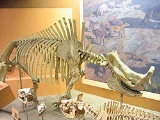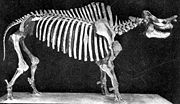
Brontotherium
Encyclopedia
Brontotherium is an extinct genus
of prehistoric odd-toed ungulate
mammal
of the family
Brontotheriidae
, an extinct group of rhinoceros
-like browsers related to horse
s. The genus was found in North America
during the Late Eocene
.
Many Brontotherium remains have been found in South Dakota
and Nebraska
. In the past, specimens exposed by severe rainstorms were found by Native Americans
of the Sioux
tribe. The Sioux believed these creatures produced thunderstorm
s when running over the cloud
s, and called them 'thunder horses'. Many of the skeleton
s found by the Sioux belonged to herd
s which were killed by volcanic eruptions of the Rocky Mountains
, which were volcanically active at the time.
According to Mihlbachler et al. 2004, the species within genus Brontotherium were merged with the genus Megacerops
, though not all authorities agree on this.

-like protrusion on its nose, with blunt ends.
Brontotheriums dorsal vertebrae above the shoulders had extra long spines to support the huge neck muscles needed to carry the heavy skull
. Possibly, Brontotherium had fleshy lips and a long tongue, perfect for carefully selecting food. The shape of its teeth suggests that it preferred food such as soft stems and leaves, rather than tough vegetation.
Genus
In biology, a genus is a low-level taxonomic rank used in the biological classification of living and fossil organisms, which is an example of definition by genus and differentia...
of prehistoric odd-toed ungulate
Odd-toed ungulate
An odd-toed ungulate is a mammal with hooves that feature an odd number of toes. Odd-toed ungulates comprise the order Perissodactyla . The middle toe on each hoof is usually larger than its neighbours...
mammal
Mammal
Mammals are members of a class of air-breathing vertebrate animals characterised by the possession of endothermy, hair, three middle ear bones, and mammary glands functional in mothers with young...
of the family
Family (biology)
In biological classification, family is* a taxonomic rank. Other well-known ranks are life, domain, kingdom, phylum, class, order, genus, and species, with family fitting between order and genus. As for the other well-known ranks, there is the option of an immediately lower rank, indicated by the...
Brontotheriidae
Brontotheriidae
Brontotheriidae, also called Titanotheriidae, is a family of extinct mammals belonging to the order Perissodactyla, the order that includes horses, rhinoceroses, and tapirs. Superficially they looked rather like rhinos, although they were not true rhinos and are probably most closely related to...
, an extinct group of rhinoceros
Rhinoceros
Rhinoceros , also known as rhino, is a group of five extant species of odd-toed ungulates in the family Rhinocerotidae. Two of these species are native to Africa and three to southern Asia....
-like browsers related to horse
Horse
The horse is one of two extant subspecies of Equus ferus, or the wild horse. It is a single-hooved mammal belonging to the taxonomic family Equidae. The horse has evolved over the past 45 to 55 million years from a small multi-toed creature into the large, single-toed animal of today...
s. The genus was found in North America
North America
North America is a continent wholly within the Northern Hemisphere and almost wholly within the Western Hemisphere. It is also considered a northern subcontinent of the Americas...
during the Late Eocene
Eocene
The Eocene Epoch, lasting from about 56 to 34 million years ago , is a major division of the geologic timescale and the second epoch of the Paleogene Period in the Cenozoic Era. The Eocene spans the time from the end of the Palaeocene Epoch to the beginning of the Oligocene Epoch. The start of the...
.
Many Brontotherium remains have been found in South Dakota
South Dakota
South Dakota is a state located in the Midwestern region of the United States. It is named after the Lakota and Dakota Sioux American Indian tribes. Once a part of Dakota Territory, South Dakota became a state on November 2, 1889. The state has an area of and an estimated population of just over...
and Nebraska
Nebraska
Nebraska is a state on the Great Plains of the Midwestern United States. The state's capital is Lincoln and its largest city is Omaha, on the Missouri River....
. In the past, specimens exposed by severe rainstorms were found by Native Americans
Native Americans in the United States
Native Americans in the United States are the indigenous peoples in North America within the boundaries of the present-day continental United States, parts of Alaska, and the island state of Hawaii. They are composed of numerous, distinct tribes, states, and ethnic groups, many of which survive as...
of the Sioux
Sioux
The Sioux are Native American and First Nations people in North America. The term can refer to any ethnic group within the Great Sioux Nation or any of the nation's many language dialects...
tribe. The Sioux believed these creatures produced thunderstorm
Thunderstorm
A thunderstorm, also known as an electrical storm, a lightning storm, thundershower or simply a storm is a form of weather characterized by the presence of lightning and its acoustic effect on the Earth's atmosphere known as thunder. The meteorologically assigned cloud type associated with the...
s when running over the cloud
Cloud
A cloud is a visible mass of liquid droplets or frozen crystals made of water and/or various chemicals suspended in the atmosphere above the surface of a planetary body. They are also known as aerosols. Clouds in Earth's atmosphere are studied in the cloud physics branch of meteorology...
s, and called them 'thunder horses'. Many of the skeleton
Skeleton
The skeleton is the body part that forms the supporting structure of an organism. There are two different skeletal types: the exoskeleton, which is the stable outer shell of an organism, and the endoskeleton, which forms the support structure inside the body.In a figurative sense, skeleton can...
s found by the Sioux belonged to herd
Herd
Herd refers to a social grouping of certain animals of the same species, either wild or domestic, and also to the form of collective animal behavior associated with this or as a verb, to herd, to its control by another species such as humans or dogs.The term herd is generally applied to mammals,...
s which were killed by volcanic eruptions of the Rocky Mountains
Rocky Mountains
The Rocky Mountains are a major mountain range in western North America. The Rocky Mountains stretch more than from the northernmost part of British Columbia, in western Canada, to New Mexico, in the southwestern United States...
, which were volcanically active at the time.
According to Mihlbachler et al. 2004, the species within genus Brontotherium were merged with the genus Megacerops
Megacerops
Megacerops is an extinct genus of the family Brontotheriidae endemic to North America during the Late Eocene epoch , existing for approximately .-Taxonomy:...
, though not all authorities agree on this.

Description
Brontotherium stood about 2.5 metres (8.2 ft) tall at the shoulders and resembled a large rhinoceros, possessing a Y-shaped hornHorn (anatomy)
A horn is a pointed projection of the skin on the head of various animals, consisting of a covering of horn surrounding a core of living bone. True horns are found mainly among the ruminant artiodactyls, in the families Antilocapridae and Bovidae...
-like protrusion on its nose, with blunt ends.
Brontotheriums dorsal vertebrae above the shoulders had extra long spines to support the huge neck muscles needed to carry the heavy skull
Skull
The skull is a bony structure in the head of many animals that supports the structures of the face and forms a cavity for the brain.The skull is composed of two parts: the cranium and the mandible. A skull without a mandible is only a cranium. Animals that have skulls are called craniates...
. Possibly, Brontotherium had fleshy lips and a long tongue, perfect for carefully selecting food. The shape of its teeth suggests that it preferred food such as soft stems and leaves, rather than tough vegetation.

